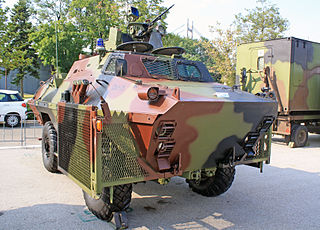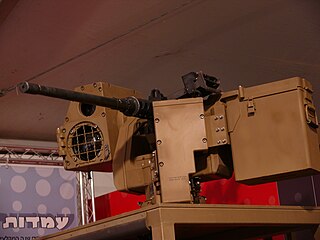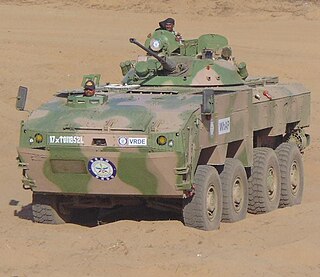Kongsberg Defence & Aerospace (KDA) is one of three business units of Kongsberg Gruppen (KONGSBERG) of Norway and a supplier of defence and space related systems and products, mainly anti-ship missiles, military communications, and command and weapons control systems for naval vessels and air-defence applications. Today, the company is probably best known abroad for its development/industrialisation and production of the first passive IR homing anti-ship missile of the western world, the Penguin, starting delivery in the early 1970s. As of 2021, Kongsberg Defence & Aerospace had 3,500 employees.

The Stryker is a family of eight-wheeled armored fighting vehicles derived from the Canadian LAV III. Stryker vehicles are produced by General Dynamics Land Systems-Canada (GDLS-C) for the United States Army in a plant in London, Ontario. It has four-wheel drive (8×4) and can be switched to all-wheel drive (8×8).

The Boxer is a multirole armoured fighting vehicle designed by an international consortium to accomplish a number of operations through the use of installable mission modules. The governments participating in the Boxer programme have changed as the programme has developed. The Boxer vehicle is produced by the ARTEC GmbH industrial group, and the programme is being managed by OCCAR. ARTEC GmbH is based in Munich; its parent companies are KNDS Deutschland GmbH & Co and Rheinmetall Land Systeme GmbH on the German side, and Rheinmetall Defence Nederland B.V. for the Netherlands. Overall, Rheinmetall has a 64% stake in the joint venture.

The M230 Cannon is a 30 mm (30×113 mm), single-barrel electrically-driven autocannon, using external electrical power to cycle the weapon between shots. It was designed and manufactured originally by Hughes Helicopters in Culver City, California. As of 2019, it is produced by Northrop Grumman Innovation Systems.

The Australian Light Armoured Vehicle (ASLAV) is an eight-wheeled armoured reconnaissance vehicle of the LAV II family used by the Australian Army. It was built by General Dynamics Land Systems Canada, and developed from the U.S. Marine Corps' LAV-25 and Canadian Army's Bison armoured fighting vehicles.

The Bionix (BX) is a family of tracked Singaporean armoured fighting vehicles developed by ST Kinetics. Intended to augment the Singapore Army's aging M113 armoured personnel carriers, it is the first indigenous armoured vehicle to be developed in Southeast Asia. The Bionix has been operational with the Singapore Armed Forces (SAF) since 1999 in a wide variety of adaptations including the Bionix II, Bionix 25 and Bionix 40/50 variants.

The LAV III is the third generation of the Light Armoured Vehicle (LAV) family of armored personnel carriers built by General Dynamics Land Systems – Canada (GDLS-C), a London, Ontario, based subsidiary of General Dynamics. It first entered service in 1999, succeeding the LAV II. It is the primary mechanized infantry vehicle of both the Canadian Army and the New Zealand Army. It also forms the basis of the Stryker vehicle used by the U.S. Army and other operators. The Canadian Army is upgrading its LAV IIIs to the LAV 6 standard. Early in its development history it was referred to as the 'Kodiak', but the name was never officially adopted.

The Mk44 Bushmaster II is a 30 mm chain gun manufactured by Northrop Grumman. It is a derivative of the 25 mm M242 Bushmaster, and uses 70% of the same parts as the M242 while increasing the firepower by as much as 50% with the 20% increase in caliber size. The barrel is chromium-plated for extended life. The gun uses standard GAU-8 Avenger ammunition that is available in API, HEI and APFSDS-T variants.
A huge number of M113 armored personnel carrier variants have been created, ranging from infantry carriers to nuclear missile carriers. The M113 armored personnel carrier has become one of the most prolific armored vehicles of the second half of the 20th century, and continues to serve with armies around the world in many roles.

A remote controlled weapon station (RCWS), remotely operated weapon system (ROWS), or remote weapon system (RWS), is a remotely operated light or medium-caliber weapon system, often equipped with a fire-control system, that can be installed on a ground combat vehicle or sea- and air-based combat platform.

The Protector RWS is a remotely controlled weapons station (RWS) that can be mounted to vehicles and stationary platforms. It has been in full scale production since December 2001. It is manufactured by Kongsberg Defence & Aerospace of Norway.

The M1126 infantry carrier vehicle (ICV) is an armored personnel carrier and part of the Stryker family of vehicles (derived from the Canadian LAV III/Swiss MOWAG Piranha IIIH 8x8) used by the United States Army and Royal Thai Army. Models with the double V-hull upgrade are known as the M1256 ICVV.

The M901 ITV is an American armored vehicle introduced into service in 1979, and designed to carry a dual M220 TOW launcher. It is based on the M113 armored personnel carrier chassis. The M901 ITV is no longer in service with the United States Army, its primary user.

The BOV, is an all-wheel drive armoured vehicle manufactured in the former Yugoslavia and today in Serbia. The second generation BOV is currently in development.

The Samson Remote Controlled Weapon Station (RCWS), also known as Katlanit is a remote weapon system (RWS) that enables a variety of devices to be operated automatically or by remote control, including 5.56 mm, 7.62 mm, and 12.7 mm .50 BMG machine guns, 40 mm automatic grenade launchers, anti-tank missiles and observation pods.

The Nanuk is a remote weapon station (RWS) used for light and medium calibre weapons which can be installed on any type of armoured vehicles or brown water patrol vessel. It is designed by Rheinmetall Canada, in Quebec, Canada. The word Nanuk (ᓇᓄᖅ) means "polar bear" in Inuktitut.

The Ripsaw is a series of developmental unmanned ground combat vehicles designed by Howe & Howe Technologies for evaluation by the United States Army.

The TATA Kestrel, also known as the IPMV , a variant of DRDO developed WhAP, is a family of armoured personnel carriers developed by Tata Advanced Systems and the Defence Research and Development Organisation (DRDO). It was developed to replace Soviet-era BMP-1 and BMP-2 and APCs in service with the Indian Army.

The LAV 6, sometimes written as LAV 6.0 or LAV VI, is the fourth generation of LAV, and is based on the LAV III. The first vehicles were delivered in 2013 and after testing entered service in 2016. The Canadian Army plans to replace its entire LAV fleet of various LAV II and LAV III variants with the LAV 6. The vehicle is being acquired in two main variants: a fighting vehicle equipped with the 25mm cannon seen on the LAV II and LAV III, and a support variant labelled the Armoured Combat Support Vehicle (ACSV).


















